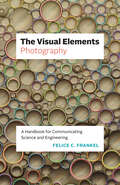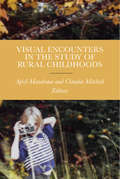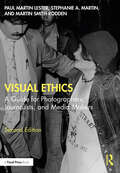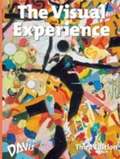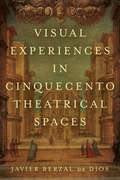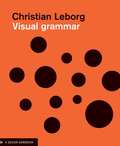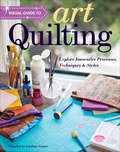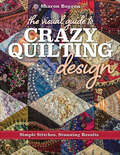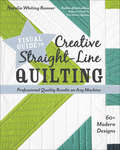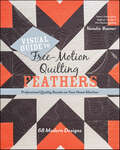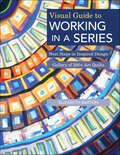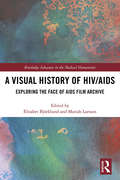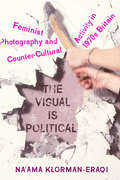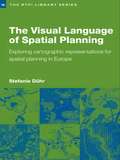- Table View
- List View
The Visual Elements—Photography: A Handbook for Communicating Science and Engineering (The Visual Elements)
by Felice C. FrankelFor novice or pro, primary investigator or postdoc, the essentials for photographing science and technology for journals, grant applications, and public understanding. Award-winning photographer Felice C. Frankel, whose work has graced the covers of Science, Nature,and Scientific American, among other publications, offers a quick guide for scientists and engineers who want to communicate—and better understand—their research by creating compelling photographs. Like all the books in the Visual Elements series, this short guide uses engaging examples to train researchers to learn visual communication. Distilling her celebrated books and courses to the essentials, Frankel shows scientists and engineers the importance of thinking visually. When she creates stunning images of scientific phenomena, she is not only interested in helping researchers to convey understanding to others in their research community or to gain media attention, but also in making these experts themselves “look longer” to understand more fully. Ideal for researchers who want a foothold for presenting and preparing their work for conferences, journal publications, and funding agencies, the book explains four tools that all readers can use—a phone, a camera, a scanner, and a microscope—and then offers important advice on composition and image manipulation ethics. The Visual Elements—Photography is an essential element in any scientist’s, engineer’s, or photographer’s library.
Visual Encounters in the Study of Rural Childhoods
by April Mandrona Claudia Mitchell Bernard Chan Naydene De Lange Karren Eppley Wendy Ewald Eric Gottesman Sally Campbell Galman Diana Carolina Gomez Helle Stranfaard Jensen Renee Jackson Rahul Kamble Irina Kosterina Jonathan Kremser Barbara Turk Niskac Sara Nyhlen Katarina Gritli Nygren Katja Gillander-Gadin Eva Soderberg Kelly Royds Beth Shively Jennifer Vanderburgh Sheilah Wilson Holley Wlodarczyk Relebohile MoletsaneVisual Encounters in the Study of Rural Childhoods brings together visual studies and childhood studies to explore images of childhood in the study of rurality and rural life. The volume highlights how the voices of children themselves remain central to investigations of rural childhoods. Contributions look at representations and experiences of rural childhoods from both the Global North and Global South (including U.S., Canada, Haiti, India, Sweden, Slovenia, South Africa, Russia, Timor-Leste, and Colombia) and consider visuals ranging from picture books to cell phone video to television.
Visual Ethics: A Guide for Photographers, Journalists, and Filmmakers
by Paul Martin LesterVisual Ethics addresses the need for critical thinking and ethical behavior among professionals responsible for visual messages in photography and photojournalism, film, and digital media. From the author of Photojournalism: An Ethical Approach, published more than 20 years ago, this book goes beyond photojournalism ethics. It discusses crucial contemporary concerns, including persuasion, stereotyping, global perspectives, graphic design decisions, multimedia production, social media, and more. Written for an ever-growing discipline, author Paul Martin Lester gives serious ethical consideration to the complex field of visual communication.
Visual Ethics: A Guide for Photographers, Journalists, and Media Makers
by Paul Martin Lester Stephanie A. Martin Martin Smith-RoddenAn indispensable guide to visual ethics, this book addresses the need for critical thinking and ethical behavior among students and professionals responsible for a variety of mass media visual messages. Written for an ever-growing discipline, authors Paul Martin Lester, Stephanie A. Martin, and Martin Rodden-Smith give serious ethical consideration to the complex field of visual communication. The book covers the definitions and uses of six philosophies, analytical methods, cultural awareness, visual reporting, documentary, citizen journalists, advertising, public relations, typography, graphic design, data visualizations, cartoons, motion pictures, television, computers and the web, augmented and virtual reality, social media, the editing process, and the need for empathy. At the end of each chapter are case studies for further analysis and interviews with thoughtful practitioners in each field of study, including Steven Heller and Nigel Holmes. This second edition has also been fully revised and updated throughout to reflect on the impact of new and emerging technologies. This book is an important resource for students of photojournalism, photography, filmmaking, media and communication, and visual communication, as well as professionals working in these fields.
Visual Ethics: A Guide for Photographers, Journalists, and Media Makers
by Paul Martin Lester Stephanie A. Martin Martin Smith-RoddenAn indispensable guide to visual ethics, this book addresses the need for critical thinking and ethical behavior among students and professionals responsible for a variety of mass media visual messages.Written for an ever-growing discipline, authors Paul Martin Lester, Stephanie A. Martin, and Martin Rodden-Smith give serious ethical consideration to the complex field of visual communication. The book covers the definitions and uses of six philosophies, analytical methods, cultural awareness, visual reporting, documentary, citizen journalists, advertising, public relations, typography, graphic design, data visualizations, cartoons, motion pictures, television, computers and the web, augmented and virtual reality, social media, the editing process, and the need for empathy. At the end of each chapter are case studies for further analysis and interviews with thoughtful practitioners in each field of study, including Steven Heller and Nigel Holmes. This second edition has also been fully revised and updated throughout to reflect on the impact of new and emerging technologies.This book is an important resource for students of photojournalism, photography, filmmaking, media and communication, and visual communication, as well as professionals working in these fields.
The Visual Experience
by Jack Hobbs Richard Salome Ken ViethLEVEL: Key Stage 4 onwards. A comprehensive art appreciation program, 'The Visual Experience' is a complete visual art curriculum that integrates art history, aesthetics, criticism, and production. The third edition has: All new studio experiences; More artists biographies; More contemporary art; Step-by-step art criticism in every major chapter; Writing emphasised throughout.
The Visual Experience
by Jack Hobbs Richard Salome Ken ViethLEVEL: Key Stage 4 onwards. A comprehensive art appreciation program, 'The Visual Experience' is a complete visual art curriculum that integrates art history, aesthetics, criticism, and production. The third edition has: All new studio experiences; More artists biographies; More contemporary art; Step-by-step art criticism in every major chapter; Writing emphasised throughout.
The Visual Experience (2nd Edition)
by Jack Hobbs Richard SalomeDesigned for students, this volume explores the expression and construction of art, and discusses the creative and technical processes of art. The book consists of different elements that will help you understand what art is, how it is made, and how it can make your life richer.
Visual Experiences in Cinquecento Theatrical Spaces (Toronto Italian Studies)
by Javier Berzal de DiosThrough an interdisciplinary examination of sixteenth-century theatrical spaces, Visual Experiences in Cinquecento Theatrical Spaces studies the performative aspects of the early modern stage, paying special attention to the overlooked complexities of audience experience. Examining the period’s philosophical and aesthetic ideas about space, place, and setting, the book shows how artists consciously moved away from traditional representations of real spaces on stages to conjure spectacles that pushed their collective audiences towards more imaginative, collaborative engagements no longer tethered to strict definitions of naturalism. In this way, Visual Experiences breaks with traditional interpretations of early modern staging techniques, arguing that the goal of early modern artists was not the creation of a naturalistically unified stage constructed for a single, privileged viewer, but rather a complex multimedia experience addressing a diverse set of viewers. In stressing the wider scenographic possibilities of the sixteenth-century stage, the book focuses on how space created various modes of audience engagement.
Visual Grammar
by Christian LeborgLeborg (founder of K, "a knowledge and communications consultancy in Oslo, Norway") presents a primer and grammatical dictionary of elements of visual communication found in graphic design. The volume covers abstract objects and structures such as dimension, format and volume; concrete objects and structures including form, size, color, and texture; activities such as repetition and mirroring; and relations between several objects in a composition by pairing illustrative drawings with brief textual definitions.
Visual Guide to Art Quilting: Explore Innovative Processes, Techniques & Styles
by Lindsay ConnerThis visual reference will help anyone inspired to make art quilts gain the practical tools and inspiration necessary to translate your ideas to fabric. Start on the path to art quilting success! For anyone inspired to make art quilts, this visual reference includes step-by-step photos and illustrations to guide you on your creative journey. Dip your toes in the water with an introduction from some of the biggest names in quilting arts to design theory, supplies and tools, and working with fabric. Practice surface design, embellishment, and quilting by hand and machine as you learn a variety of finishing techniques to turn your unique ideas and imagery into art quilts. • Expand your art quilter&’s toolbox with helpful lessons, plus step-by-step photos and illustrations • Study dyeing and printing on fabrics, embellishment, quilting, and working in a series • Gain the practical tools and inspiration you need to finally translate your ideas to fabric
The Visual Guide to Crazy Quilting Design: Simple Stitches, Stunning Results
by Sharon BoggonSee it, stitch it! Thirty-five contemporary crazy-quilting stitches, photographed step by step. Rooted in the Victorian era, crazy quilting has a powerful allure for today's quilters, who use it to let loose and tell a unique story with fabric. Embrace crazy quilting with thirty-five must-know stitches and endless variations, shown in clear, step-by-step photographs for both right- and left-handed stitchers. Fine artist Sharon Boggon reveals design fundamentals to guide you in your process, so you can sew thoughtful, visually appealing blocks. Learn the theory and process behind this fascinating art: how to choose fabrics, piece stitch-and-flip blocks, and embellish seams with embroidery, beads, buttons, and charms. • Learn crazy-quilting techniques with colorful photos that show every detail • Combine fabric, embellishments, and thirty-five stitches, plus endless variations, into stunning crazy quilts as unique as you • Unpack savvy design principals to make order of the chaos and guide the viewer's eye around the block
Visual Guide to Creative Straight-Line Quilting: Professional-Quality Results on Any Machine
by Natalia Whiting BonnerDiscover how to machine quilt using straight lines with one of 48 quilting ideas and 13 variations, from the author of Modern One-Block Quilts.Are feathers and swirls your fallback? Learn how satisfying it is to quilt with only straight lines! Quilting expert Natalia Bonner shares sixty new straight-line motifs to fill in triangles, square blocks, and borders, plus allover designs. Teach your walking foot some new tricks or practice controlled free-motion quilting with rulers. Domestic or longarm machine . . . the choice is yours! Each pattern comes with step-by-step photos, so quilters of all levels can conquer their fears of straight-line quilting, and learn to rock it!• Natalia Bonner fans, unite! Learn forty-eight straight-line quilting ideas and thirteen fun variations• Find freedom in the constraints of straight-line quilting and shine a spotlight on every intriguing angle• Use a longarm or home sewing machine to create geometric perfection, step-by-step
Visual Guide to Free-Motion Quilting Feathers: Professional Quality Results on Your Home Machine
by Natalia BonnerPut a feather in your quilting cap Take the fear out of quilting feathers! Explore 68 modern feather designs with step-by-step guidance from award-winning quilter Natalia Bonner. Quilt stunning feathers on a variety of blocks and borders with this beginner-friendly, visual guide. Unlike traditional feather quilting, which relies on exactness and precision, Natalia’s ideas will help you break away from perfection and find creativity in your quilting practice. Use your home sewing machine or a longarm to free-motion feathers with confidence, adding a truly elegant finish to today’s modern quilts. • 68 modern feather designs! Beginner-friendly techniques from best-selling author Natalia Bonner • Kick your feather fears to the curb with an easy-to-use guide for domestic and longarm quilters • Finish blocks and borders with unique feather motifs to complement today’s modern quilts
Visual Guide to Patchwork & Quilting: Fabric Selection to Finishing Techniques & Beyond
by C&T PublishingYour one-stop shop for everything quilting! Absorb the knowledge of more than 20 quilt experts in one place! With hundreds of photographs and illustrations to help you plan your quilting projects, this comprehensive guide answers all of your quiltmaking questions. Included in this comprehensive reference guide: fabric 101; piecing and applique by hand and machine; understanding color, value, and quilt design; start-to-finish quilt construction; quilting motifs, tips, and tricks; beyond the basics; plus a handy index. It's the must-have book for any quilter! • A quilter's complete handbook with 25 block patterns and projects galore • Learn rotary cutting, pressing, piecing, and applique, as well as advanced techniques like quilt-as-you-go, crazy quilting, and more • Pick the right supplies, tools, and fabric every time! All about precuts, colors, and quilt design basics • Finish your quilt like a pro, from the "quilt sandwich" to hand- and machine-quilting motifs to binding
Visual Guide to Working in a Series: Next Steps in Inspired Design
by Elizabeth BartonDeepen your quilt artistry by creating quilts in a series This inspiring guide from art quilter Elizabeth Barton is for quilt artists who have mastered the basics and want to explore deeper levels of creativity and skill. Learn how making a series of quilts can help you generate more ideas, find new subtleties in favorite subjects, and build a body of work for shows. Packed with hands-on lessons and examples, this book will transform your work and enlarge your creative vision forever. • Creative exercises help you develop your own themes and techniques • Includes huge gallery of more than 200 examples from Elizabeth and other working art quilters • Explains how working in a series elevates creativity and artistic depth
A Visual History of HIV/AIDS: Exploring The Face of AIDS film archive (Routledge Advances in the Medical Humanities)
by Elisabet Björklund Mariah LarssonThe Face of AIDS film archive at Karolinska Institutet, Sweden, consists of more than 700 hours of unedited and edited footage, shot over a period of more than thirty years and all over the world by filmmaker and journalist Staffan Hildebrand. The material documents the HIV/AIDS pandemic and includes scenes from conferences and rallies, and interviews with activists, physicians, people with the infection, and researchers. It represents a global historical development from the early years of the AIDS crisis to a situation in which it is possible to live a normal life with the HIV virus. This volume brings together a range of academic perspectives – from media and film studies, medical history, gender studies, history, and cultural studies – to bear on the archive, shedding light on memories, discourses, trauma, and activism. Using a medical humanities framework, the editors explore the influence of historical representations of HIV/AIDS and stigma in a world where antiretroviral treatment has fundamentally altered the conditions under which many people diagnosed with HIV live. Organized into four sections, this book begins by introducing the archive and its role, setting it in a global context. The first part looks at methodological, legal and ethical issues around archiving memories of the present which are then used to construct histories of the past; something that can be particularly controversial when dealing with a socially stigmatized epidemic such as HIV/AIDS. The second section is devoted to analyses of particular films from the archive, looking at the portrayal of people living with HIV/AIDS, the narrative of HIV as a chronic illness and the contemporary context of particular films. The third section looks at how stigma and trauma are negotiated in the material in the Face of AIDS film archive, discussing ideas about suffering and culpability. The final section contributes perspectives on and by the filmmaker as activist and auteur. This interdisciplinary collection is placed at the intersection of medical humanities, sexuality studies and film and media studies, continuing a tradition of studies on the cultural and social understandings of HIV/AIDS.
Visual Inference for IoT Systems: A Practical Approach
by Angel Rodríguez-Vázquez Jorge Fernández-Berni Delia Velasco-MonteroThis book presents a systematic approach to the implementation of Internet of Things (IoT) devices achieving visual inference through deep neural networks. Practical aspects are covered, with a focus on providing guidelines to optimally select hardware and software components as well as network architectures according to prescribed application requirements. The monograph includes a remarkable set of experimental results and functional procedures supporting the theoretical concepts and methodologies introduced. A case study on animal recognition based on smart camera traps is also presented and thoroughly analyzed. In this case study, different system alternatives are explored and a particular realization is completely developed. Illustrations, numerous plots from simulations and experiments, and supporting information in the form of charts and tables make Visual Inference and IoT Systems: A Practical Approach a clear and detailed guide to the topic. It will be of interest to researchers, industrial practitioners, and graduate students in the fields of computer vision and IoT.
The Visual is Political: Feminist Photography and Countercultural Activity in 1970s Britain
by Na'Ama Klorman-EraqiThe Visual is Political examines the growth of feminist photography as it unfolded in Britain during the 1970s and 1980s. This period in Britain was marked by instability following the collapse of the welfare state, massive unemployment, race riots, and workers’ strikes. However, this was also a time in which various forms of social activism emerged or solidified, including the Women’s Movement, whose members increasingly turned to photography as a tool for their political activism. Rather than focusing on the aesthetic quality of the images produced, Klorman-Eraqi looks at the application of feminist theory, photojournalism, advertising, photo montage, punk subculture and aesthetics, and politicized street activity to emphasize the statement and challenge that the photographic language of these works posed. She shows both the utilitarian uses of photography in activism, but also how these same photographers went on to be accepted (or co-opted) into the mainstream art spaces little by little, sometimes with great controversy. The Visual is Political highlights the relevance and impact of an earlier contentious, creative, and politicized moment of feminism and photography as art and activism.
Visual Journalism and Verification at War: Norwegian and Swedish News Outlets Covering Ukraine (Disruptions)
by Maria Nilsson Anne Hege SimonsenConsidering the visual coverage of the war in Ukraine, this book provides critical insights into how newsrooms make use of visual materials, how visuals partake in journalistic storytelling in a modern wartime context, and how visual journalism practices affect the news media’s role as arbiter of accuracy and ethics.Based on a mixed-methods study, including analyses of selected visually driven news stories and interviews with media professionals in Norwegian and Swedish national media outlets houses, this book examines the news media’s approach to the visual coverage of the war in Ukraine following Russian invasion in 2022. The work is theoretically underpinned by ongoing boundary work within journalism, and editorial negotiations over issues such as verification, source criticism, and trust; witnessing and ways of seeing; and ethical gatekeeping in photojournalism. At a juncture of rising concerns over AI, public distrust, and propaganda, this study adds a real-time aspect to these debates and reveals challenges as well as emerging strategies in the unfolding coverage. Furthermore, the comparative Scandinavian context serves to highlight points of tension between the global and the local; between those newsrooms relying on global image brokers and those conducting their own in-house reporting.Written for researchers and advanced students of Visual Journalism and Conflict Reporting, this book is a timely intervention.
The Visual Language of Spatial Planning: Exploring Cartographic Representations for Spatial Planning in Europe (RTPI Library Series)
by Stefanie DührAt a time when strategic spatial planning is undergoing a renaissance in Europe, The Visual Language of Spatial Planning makes a unique contribution to this rapidly growing area of teaching and research. Discussing the relevant theoretical perspectives on policy-making and planning, combined with cartographic communication and the use of cartographic representations in the planning process, Stephanie Duhr provides conceptual and practical tools to help students and practitioners better understand maps and visualizations in strategic spatial planning. The book is the first to review the form, style and use of cartographic representations in strategic spacial plans in the Netherlands, Germany and England as well as at European level. Significant differences between planning traditions and the impact of these on transnational planning processes are highlighted. It concludes by discussing the practical implications for future strategic spacial planning processes in Europe and the best use of cartographic representations to reach agreement and to focus dialogue.
The Visual Language of Technique
by Luigi CocchiarellaThe book is inspired by the third seminar in a cycle connected to the celebrations of the 150th anniversary of the Politecnico di Milano (July 2013). "Educating by Image. Teaching Styles vs Learning Styles" was the motto of this meeting. The contributions (coming from lectures, the poster session, interviews and round table) aim to propose an updated look at visual education, highlighting how digital tools and networks have profoundly affected the "representational styles" of the teachers and the "cognitive styles" of the learners, while at the same time reaffirming the importance of the interaction between the two groups. As Herbert Alexander Simon once said, "Learning results. . . only from what the student does and thinks"; therefore "the teacher can advance learning only by influencing what the student does to learn". That is no mean feat if we consider that, according to Benjamin Samuel Bloom, visual education not only involves the pure cognition, but also the affective and the psychomotor domains, not to mention the social aspects. This is why, alongside some theoretical and historical retrospectives, the contributions recommend a continuous revision of "what" and "how" could be included in the academic curricula, also in connection with secondary schools, the professional world, targeted Lifelong Learning Programmes for students and teachers. The volume includes an interview with the science journalist and writer Piero Angela.
The Visual Legacy of Alexander the Great from the Renaissance to the Age of Revolution (Routledge Research in Art History)
by Víctor Mínguez Inmaculada Rodríguez-MoyaThis is an analysis of the diverse facets of Alexander the Great’s image from the Renaissance era through the Baroque into the nineteenth century. Perceived as the first sovereign ruler of the world, for centuries Alexander became an exemplar for the most ambitious kings and emperors. This cultural phenomenon flourished above all in the Renaissance while extending into the nineteenth century. Early modern monarchs’ identification with Alexander associated them with ideas of kingly wisdom. Yet this admiration waned on occasions. Napoleon was Alexander of Macedonia’s most ardent critic. During the nineteenth century, the Macedonian hero was viewed as an individual who won control of the Achaemenid empire, but also underwent a progressive moral decline that converted him into a tyrant. The book will be of interest to scholars working in art history and iconography.
The Visual Life of Romantic Theater, 1780-1830
by Diane Piccitto Terry F. RobinsonThe Visual Life of Romantic Theater examines the dynamism and vibrancy of stage spectacle and its impact in an era of momentous social upheaval and aesthetic change. Situating theatrical production as key to understanding visuality ca. 1780-1830, this book places the stage front and center in Romantic scholarship by re-envisioning traditional approaches to artistic and social creation in the period. How, it asks, did dramaturgy and stagecraft influence aesthetic and sociopolitical concerns? How does a focus on visuality expand our understanding of the historical experience of theatergoing? In what ways did stage performance converge with visual culture beyond the theater? How did extratheatrical genres engage with theatrical sight and spectacle? Finally, how does a focus on dramatic vision change the way we conceive of Romanticism itself? The volume’s essays by emerging and established scholars provide exciting and suggestive answers to these questions, along with a more capacious conception of Romantic theater as a locus of visual culture that reached well beyond playhouse walls.
